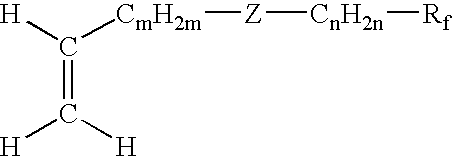Fluorochemical treatment for silicon articles
- Summary
- Abstract
- Description
- Claims
- Application Information
AI Technical Summary
Benefits of technology
Problems solved by technology
Method used
Image
Examples
example 12
[0147] A 0.5 cm.times.0.5 cm square silicon chip having a series of unreleased (i.e., still having a protective photoresist) MEMS cantilever beams (similar to that described in R. Maboudian et al., Tribology Letters, vol. 3, pp. 215-221 (1997), the disclosure of which is incorporated herein by reference) was made utilizing the Cronos MUMPS process with the following noted changes. The unreleased beams were made of polycrystalline silicon and positioned parallel to the polycrystalline silicon surface at a distance of 2 micrometers. The beams were regularly spaced to form an array (20 micrometers pitch), 3.5 micrometers thick, 10 micrometers wide, and had lengths varying in intervals of 50 micrometers from 200 to 1500 micrometers. The chip also had reference posts having a height of 5.5 micrometers thickness.
[0148] To remove protective photoresist resulting from the MUMPS process, the chip was sonicated in acetone for 20 min using an ultrasonic bath, obtained under the trade designati...
example 19
[0158] carried out according to General Method C, except that a polycrystalline silicon wafer (10,000 .ANG. undoped polysilicon on a 100 mm diameter Si(100) wafer obtained from WaferNet; prepared according to General Procedure A with the exception that the wafer piece was etched in CMOS grade 49 percent by weight aqueous HF for 3 min instead of etching in the ammonium fluoride solution) was used as the substrate, and E1 was used at 45 weight percent in a mixture of 5 weight percent 2-hydroxy-2-methyl-1-phenyl-1-propanone and 50 weight percent heptane.
[0159] Example 20 was carried out as in Example 19 except that E1 was used at 5 weight percent in a mixture of 5 weight percent 2-hydroxy-2-methyl-1-phenyl-1-propanone and 90 weight percent heptane.
[0160] Example 21 was carried out using a 1.times.1 cm piece of silicon (100) (obtained from WaferNet). The piece was cleaned by sequentially rinsing it in heptane, acetone, and isopropyl alcohol. The cleaned piece was subjected for 10 min to...
example 22
[0165] A silicon chip, prepared as in Example 12, containing MEMS cantilever beams and having the photoresist removed, was placed in the "fill / drain" apparatus. A volume of 5 mL CMOS grade 49 percent by weight aqueous HF was added to the apparatus and allowed to etch the chip for 3 min to release the cantilever beam MEMS devices. The chip was then washed with 10.times.25 mL portions of deionized water (.gtoreq.18 megohms resistance) over a total period of 10 min. After the last of the water was drained, 5 mL of CMOS grade 49 percent by weight aqueous HF was added and allowed to etch the MEMS chip again for 3 min. The aqueous HF was again drained. The etched chip was then sequentially washed in isopropyl alcohol for 10 min, and heptane for 10 min, each wash being performed in the same manner as the water wash, with 10 fill and drain cycles over 10 min.
[0166] The chip was removed from the heptane, and placed in a quartz tube in a solution (sparged with dry nitrogen for 15 min) contain...
PUM
| Property | Measurement | Unit |
|---|---|---|
| Percent by mass | aaaaa | aaaaa |
| Percent by mass | aaaaa | aaaaa |
| Angle | aaaaa | aaaaa |
Abstract
Description
Claims
Application Information
 Login to view more
Login to view more - R&D Engineer
- R&D Manager
- IP Professional
- Industry Leading Data Capabilities
- Powerful AI technology
- Patent DNA Extraction
Browse by: Latest US Patents, China's latest patents, Technical Efficacy Thesaurus, Application Domain, Technology Topic.
© 2024 PatSnap. All rights reserved.Legal|Privacy policy|Modern Slavery Act Transparency Statement|Sitemap



